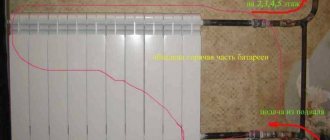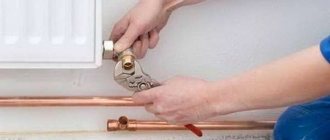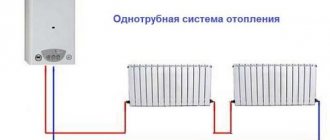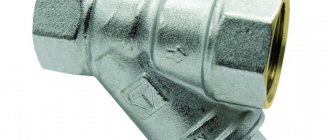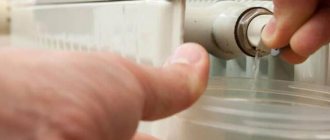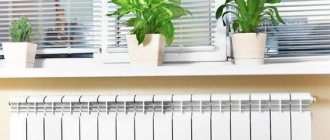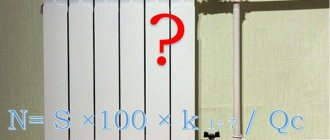Air accumulated in the heating system blocks the flow of coolant. To get rid of air pockets in the heating system, you need to bleed the air from the battery. The deaeration technique depends on the design of the radiators and the features of the system itself.
- How to drain water from cast iron batteries
Why do radiators get airy and what does this lead to?
The reasons for the appearance of air jams can be different:
- Incorrectly selected slope when installing elements of a gravity system. If the slope is insufficient or absent, circulation will be weak and air pockets will appear.
- Incorrect installation of forced circulation systems.
- Low pressure level in pipes. In their clearance there will be voids filled with air.
- Using the wrong coolant. The liquid poured into the radiator reacts with the metal from which it is made. As a result, oxygen or hydrogen is formed. They create gas-air plugs.
- Coolant overheating. Most often occurs in old single-pipe systems. Due to the high pressure, the boiling point of water in them is lowered, but if the pressure decreases, the carrier will boil, releasing gases. They form an air jam.
- Too active filling of empty communications. The coolant, entering the pipes at high speed, bubbles, and then the bubbles turn into a plug.
- Weak sealing. Air can leak inside thermal communications even through microscopic holes. Therefore, a small gap or leaking fittings can cause such a problem.
Gas-air plugs are detrimental to thermal communications. The batteries heat up poorly and unevenly, and the pipes can make a hum. But the most unpleasant thing is that gaseous substances, when reacting with metal, oxidize and destroy thermal elements. We have to do repairs and restoration. Therefore, it is necessary to get rid of gas-air sources. It is imperative to find the cause of the airing and eliminate it. Bleeding the air is a temporary solution to the problem.
Consequences of airy heating
If the plug is not removed in time, prolonged contact with oxygen will negatively affect the metal, and it may become covered with scale and begin to deteriorate. In addition, the airiness of the system affects the circulation of water, as a result of which some places overheat and others are poorly heated.
There are various methods for bleeding gas, and priority should be given to one or the other depending on the choice of coolant. And also, on the method of water circulation in the system: natural or forced.
As a result, an air valve is used to allow the air plug to be released from the radiator or a Mayevsky valve.
How to understand that the battery is airy
Signs of a possible air lock:
- The room becomes cold. The “damaged” radiator is cooler to the touch than the others and there are cold spots on it. If you knock on a cool place, a ringing sound will be heard. Liquid-filled areas sound duller.
- When you lean your ear, you can hear hissing, noise, gurgling. Sometimes these sounds are quite loud.
- With minor gas accumulations, heating does not decrease and it is difficult to determine the presence of a plug. But the accumulated gases are doing their job. Because of them, radiators and pipes leak, circulation pumps “fly” to pump coolant.
If something similar happens in the house, it means you need to get the air out urgently. Otherwise, the rooms will be cold, and system elements will have to be constantly replaced or repaired.
Carrying out repair work
If you discover signs of air in the heating system, you should not immediately start getting rid of it. First, check the circuit for integrity and tightness. After all, if there are leaks, problems will continue.
Coolant leak
Coolant leakage is the loss of fluid that occurs due to loose connections and damage to the circuit.
Photo 1. Leak in the heating system pipe. Such a problem can cause poor operation of the heating structure.
Possible leak locations and solutions:
- Pipe sections. To stop the leak, clamps and cold welding are used. If the pipe is plastic, the entire section is replaced.
- The joints between parts of the system are sealed. Welding is used.
- Loose connection of radiator sections. You will have to remove the battery and tighten the connections (on aluminum). Cast iron radiators are glued with a cloth containing epoxy resin.
This is a labor-intensive part of the work of preparing the system for the heating season. But this must be done, otherwise you may be left without heat in winter.
A constant loss of coolant will lead to unstable operation of the system.
Features of the underfloor heating system
The presence of a heated floor complicates the system; it is not easy to remove air from the floor loops.
Air plugs appear due to:
- reducing pressure;
- strong heating of the coolant;
- leak formation;
- violation of the tightness of connections;
- errors made during installation (uneven surface, pipe slope, errors in the organization of the collector);
- illiterate first launch of the system.
In order for the system to start correctly, the air is bled from it before the boiler is turned on and the coolant is heated.
If a warm floor is the main means of obtaining a comfortable temperature, then air should not be allowed into it.
Attention! A conventional system works even if there is air there. The efficiency will decrease , but heat will still flow. When air appears in the circuit, the floor will stop heating - the reason for this is the complex installation and small diameter of the pipeline.
Removing air from the floor circuit is a lengthy process:
- Only one circuit on the collector is turned on
- The pressure is built up above the working pressure ( by 15-20% ).
- The circulation pump starts at low speed. It takes some time to fill the circuit so that the coolant displaces the air. Then the next circuit is activated, so one by one all the branches passing through the collector are slowly filled.
- The process lasts several days. This is repeated until all the air is released.
- This is done with cold coolant ; heating is turned on only when it is certain that the air has completely escaped.
Reference. When installing the system, it is useful to think about equipping the floor circuit with a separator - a device for automatically removing air from the pipes.
How to bleed air from radiators
See if the Mayevsky valve - an air vent - is installed on the battery. The tap is installed on one of the connecting threaded flanges. This makes it easier to release accumulated air. In other cases, more effort will be required.
How to remove air through a faucet
Mayevsky taps, or air valves, are installed in apartment buildings instead of shut-off and control valves. This design allows air to bleed and water to drain. The faucet is a plug with a head on which there is a hole or groove. In the middle there is a tap for a slotted screwdriver. The most convenient designs are equipped with a rotary key.
The procedure is as follows:
- Turn the faucet. After several revolutions, the air will begin to bleed out with a hiss, and later a mixture of gas and coolant will flow. The liquid needs to be drained. Do not twist too much, otherwise the media, which emerges under high pressure, will splash the walls, floor and furniture.
- A fair amount of water will have to be released. In a high-rise building you will need to release 20–30 liters, that is, two or three buckets. In a private house you don’t need to drain so much - just wait until the liquid flows in an even, non-bubbling stream. After this, you can screw the tap back on.
If you don’t want to constantly bleed, buy and install an automated valve. Its price is low. But remember that automation sometimes malfunctions, so heating requires control. The automatic valve allows, if necessary, to manually release the air plug.
How to remove air without a tap
If there is no tap or valve on the radiator, you will have to bleed off the gas-air mixture through a plug. This is a flat element mounted on tow, which is located on the opposite side of the input. In old houses it is often painted over with several layers of paint and is difficult to see.
If it is not possible to isolate the room from the general house heating system, close the common riser before starting work. Otherwise there will be a flood.
You will need:
- Adjustable wrench.
- Paint thinner.
- Bucket or basin for draining water.
- Tow
First of all, soften the paint on the plug with a solvent so that you can unscrew it. Remove the element with an adjustable wrench. But even after the paint softens, the plug is unscrewed with great difficulty. Therefore, you will have to make an effort. Turn the key slowly and carefully until you hear the sound of air escaping. Bleed it and drain about three buckets of coolant. There is tow wound under the plug - replace it with a new one. Then screw everything into place.
Ventilating the heating system in this way is quite troublesome. Therefore, old radiators are now being replaced en masse with new models that are more convenient to use.
Features of automatic air vents
In order to bleed air in closed heating systems, such as underfloor heating in a house, human intervention is not required.
High performance does not reduce the strong sensitivity to impurities in the coolant, so they are installed together with filters. Filters are installed both on the supply line and on the return line. In order to remove air most effectively, their design has stages, which makes it possible to remove oxygen from each group of devices.
If the pipes were installed in a private house at a slight angle in the direction of water flow, the drain mechanism allows the heating to be ventilated with a large flow of coolant and increases the pressure.
How to bleed air from old batteries
Such models - accordions - are found in houses built a long time ago. They have one drain point for the entire riser, and it is sometimes difficult to find. Find it and start the process:
If the drain is provided on the top floor, there should be a tap on the radiator in one of the apartments. In such heating systems it is simple, with a “lamb” or “butterfly” on the rod. You just need to open it and drain the coolant. Use a heat-resistant container, since in old single-pipe systems and their later analogue, Leningradkas, the liquid temperature is very high.
If there is no thumb on the rod, use an adjustable wrench or a clamshell grip. Typically, after a few turns, bubbling water will begin to come out.
Many older batteries do not have drain devices. You will have to unscrew the plug located on the side of the case with a key. Before doing this, you need to soak the layers of paint that have dried on it with a solvent. After deflating and draining the water, change the tow under the plug and screw everything back.
You can remove the air lock from the basement, but you will have to spend a long time understanding the intricacies of the pipes, looking for your riser and unscrewing the valves on it. It is better to contact specialists so as not to leave the entire house without heat. In old houses with a direct-flow system, the air must be vented from the expansion tank located in the attic or top floor. It is also better to entrust this to the housing office employees.
Drill a hole
This air bleed option will require additional tools. The advantage will be the guarantee of successful completion of the event and the absence of the risk of thread failure. The essence of the method is as follows:
- Take a drill or screwdriver, as well as a metal drill with a diameter of 2-4 mm.
Metal drill - Prepare a self-tapping screw that can cut a hole in metal (commonly called “flea”) - the diameter should be 1 mm larger than the drill. Place a rubber ring under the head of the self-tapping screw (it’s easy to cut it yourself from leftover rubber).
Self-tapping screw with rubber seal - Using a drill with a metal drill, drill a through hole in the battery plug.
- Wait until air comes out of the formed hole.
- After the water begins to drip, screw in the self-tapping screw prepared in advance. This will prevent further coolant leakage. For greater reliability, the surface of the rubber ring adjacent to the plug can be coated with sealant.
The second way to bleed air from cast iron radiators is effective and reliable. However, the most optimal solution would be to install a special tap that will allow you to bleed air at any time and without unnecessary effort.
How to drain water from different types of batteries
The de-airing technique largely depends not on the type or material of the battery, but on the air venting devices installed on it. These can be conventional control valves, Mayevsky valves or automatic air vents.
How to drain water from cast iron batteries
Old cast iron models have simple shut-off and control valves. In this case, you just need to turn the knob or valve and drain the water. If there is a cap installed on the radiator, unscrew it with an adjustable wrench. The main problem is the imperfection of old communications. It is not always possible to remove airiness even on the top floor. Often you have to go down into the basement or up into the attic to the expansion tank to open the valve.
Modern cast iron models are equipped with air vents. For lovers of antiquity, there are even retro-style modifications of Mayevsky cranes. They differ from the standard options only in design. There are no structural differences between them.
To remove the plug, take a container and bring it to the drainage device. Turn the valve with a wrench or screwdriver. Water with bubbles will flow out. To be sure to get rid of the problem, you will have to bleed about 30 liters.
Cast iron batteries produced these days are best equipped with automatic air venting devices that do not require outside intervention. In this case, you won’t have to release anything - the gas-air mixture will come out automatically.
How to drain water from steel and bimetallic batteries
These modern models are equipped with Mayevsky valves. There is a screw on the device that needs to be loosened slightly with a screwdriver or wrench. Air will begin to escape through the side hole. Then you need to drain the water through it. In a multi-storey building - approximately 30 liters, and in a private building - less, until the air bubbles disappear.
It is advisable to install an automatic air vent on steel and bimetallic models. They immediately release the gases. Otherwise, the hydrogen and oxygen contained in the radiator space will react with metal surfaces. Rust will appear, leaks will begin and everything will have to be repaired.
How to drain water from aluminum radiators
Automatic or manual air vents are always installed on aluminum radiators. Otherwise, aluminum, which easily comes into contact with hydrogen and oxygen, will quickly lose strength.
In this case, it is quite easy to eliminate airing. If you have a Mayevsky manual valve, take a container and place it under the radiator. Turn the screw in the middle with a wrench or screwdriver, releasing the air. Then drain the water and tighten everything up.
In order for an aluminum radiator to last a long time, it is highly advisable to install an automatic air vent on it. However, with very hard water, the automation may become clogged, malfunction and not release accumulated gases. Therefore, you will have to periodically check for traffic jams.
To do this, put your ear to the radiator and listen. If you hear noise, hum, or other strange sounds, it means that there is an air blockage inside that needs to be removed.
Step by step guide
If you have a Mayevsky tap, bleeding the air from the battery is not difficult. The Mayevsky faucet is not really a faucet, but rather a plug with a plug. It looks like this (most often):
There are also other types of air vents. We will talk about them separately.
- So, Mayevsky's crane has been discovered. Now you need to remember where the key to it is. After installing the batteries, many people throw it into the back drawer. If you have no idea where it is, use a flathead screwdriver.
- A wrench (flathead screwdriver), a bucket with a handle, and some rags in case of an emergency are all you need to de-air the battery.
- We hang the bucket on the ledge of the battery. You can use a large bucket of sour cream, mayonnaise, ice cream.
- Insert the tip of a screwdriver or wrench into the slot of the screw. Make 1-2 turns counterclockwise 180 degrees. You should not completely unscrew the screw: this will not speed up the process. Moreover, returning the part to its place will be extremely problematic - the pressure in the system will not allow this to be done.
- As soon as the screw is loosened, a thin stream of water will flow from the hole on the side of the faucet and a characteristic hissing sound will be heard. All the air needs to come out. This usually happens within the first few minutes.
- The event is considered completed when warm water appears. The flow should be uniform and no extraneous sounds should be heard.
- Now you can close the tap by turning the screw in the opposite direction (clockwise) 1-2 turns. After this, the water will stop dripping, the batteries will become warm very quickly.
We recommend: Why should everyone have plumbing clamps in their home?
The air outlet hole should be at the bottom. Adjust its position before starting work. Otherwise, the water will not flow into the bucket, but onto the floor or wall.
How to avoid air jams
The easiest way to avoid air locks is with autonomous heating. The main thing is to install everything correctly:
- Place an air vent near the boiler and on the collectors, through which the bulk of the resulting gas-air mixture will escape.
- Install a separator behind the boiler to remove small air bubbles. The water flow in the separator is slowed down, the bubbles become larger and are removed through a special outlet.
- Install automatic Mayevsky valves on each radiator, through which gases escape to the outside.
If an autonomous type heating system is equipped in this way, there will be no airing in it.
In a direct-flow system, traffic jams can be avoided if the inclination of the elements is set correctly. Then the gas-air mixture will escape through the expansion tank.
In other cases, air will accumulate in the batteries. Its formation can be reduced if you monitor the tightness, carry out installations correctly, fill only the appropriate coolant and control its temperature. It would not hurt to install automatic valves to constantly remove gases from the system.
Deaeration of a centralized system
In apartment buildings and the private sector, central heating is designed with air collectors. They are located at the top point. When the heating system is aired, just open the tap. When an air lock forms, opening the air collector allows air to rise through the pipes. Thus, the entire system is filled with water, and there are no plugs left.
In apartments, to ventilate the system you just need to open the tap
In an apartment or house, you can remove the blockage by bleeding the air in the place where it formed. For this purpose, batteries are equipped with taps. It must be borne in mind that it is unacceptable to install plumbing elements. Special valves called air vents are used . If the owner of the premises installs a water tap instead of an air vent and accidentally drains a certain amount of coolant from the system, he will have to pay a fine.
The vent is opened using a special key or a regular screwdriver. Extreme care must be taken, but even if everything is done correctly, it is possible that not only air will come out of the radiator, but water will also leak out.
Advice from experts
- At the beginning of the heating season, pour water into the heating system slowly, without causing traffic jams. It is advisable to fill only from below.
- When starting up for the first time, do not heat it too much. Let the pipes and radiators first warm up to 60 degrees. Then drain some water and turn up the heat.
- When draining water through the Mayevsky tap, do not unscrew it completely or remove it. Due to the high pressure, screwing the device back in will be very difficult. There is no need to open the taps suddenly, so as not to rip them off and flood the apartment with boiling water.
- If removing air does not produce results, you need to check the entire heating system. Perhaps the reason lies in clogged pipes or risers that need to be blown out and cleaned.
In general, you can get rid of air in your heating system in simple situations yourself, but care and caution are required. If you have any doubts, it is better to entrust the matter to specialists who are confident in the thermal wiring of a house or apartment and have the necessary tools and skills.
Proper filling of the system with coolant is the key to good heating performance
Filling the system step by step:
- work begins from the bottom point on the return of the heating system; a tap must be mounted near the heating boiler;
- a hose is put on the emergency outlet of the expansion tank in case of overflow (the hose is taken outside the house or into the sewer system), the expander is filled only to 50-70% of its volume;
- tap water is supplied with low pressure when this tap is opened;
- after filling the heating system, close the tap near the return line;
- Air is removed using Mayevsky taps throughout the entire heating system;
- the heating boiler turns on;
- the heating of the entire heating system is checked;
- if any problems are detected, air pockets are additionally removed using Mayevsky cranes;
- over the course of several days, when the heating system is operating, the heating of the heating devices is checked, sometimes it is necessary to remove air pockets several times using Mayevsky taps;
- in a closed circulation system, it is necessary to bring the pressure to 2 bar, then remove the air as described above. At the same time add coolant to the required pressure; this operation is easier to perform with an assistant.
Timely removal of air from the heating system extends its service life and promotes comfort in the home during the cold season.
Causes of excess air
There are many reasons for the appearance of air; it is quite difficult to completely avoid this phenomenon. Still, the factors that cause air pockets to form in the heating system should be studied in order to minimize their impact on the system.
Most often, air enters the system:
- if the heating was initially installed incorrectly;
- if the rules for filling the heating circuit with water are not followed;
- if the tightness of the connection of individual elements of the system is broken;
- when the system lacks or incorrectly uses air exhaust devices;
- after repair work;
- when replacing the lost volume of coolant with cold water.
Improper installation of the heating system leads to its airing in cases where the pipes are laid with an incorrect slope, form loops, etc. It is best to track such areas at the design stage of autonomous heating.
Filling the circuit with water should be done according to the principle: the larger the volume of coolant, the lower the rate of its entry into the system. If water enters too quickly, in certain areas it can become a spontaneous version of the water seal, preventing the natural process of displacing air from the circuit.
Leaks often occur at the junctions of pipes and radiators. Sometimes the crack is so small that the water escaping from it evaporates almost immediately. The hole remains unnoticed, and air gradually penetrates through it, replacing the lost volume of water.
A small gap through which water flows out can cause air to enter the heating circuit and form an air lock.
Since in one way or another the circuit may still become air-filled, when designing the heating system, it is necessary to provide for the installation of special devices designed to bleed air from the heating system. If you already have such air vents, but they do not give the desired effect, some of them may be broken and require replacement.
It also happens that air removal devices are ineffective due to their incorrect installation or insufficient quantity. It is inevitable that air will enter the system after it is repaired. In this case, it will be necessary to carry out de-airing measures.
Air dissolved in water enters the heating system while the circuit is filling. When heated, it is released in the form of small bubbles, from which an air plug is formed.
If part of the coolant volume is lost, it must be replenished. Fresh water, unlike what is already in the system, contains a certain amount of air dissolved in it. When heated, it releases in the form of small bubbles and accumulates, forming plugs.
If fresh coolant has been added to the system, after a while it will not hurt to make sure that it is not air-filled anywhere.
Removing air through a bleeder in aluminum, bimetallic and cast iron batteries
The advantages of aluminum batteries are their affordable price and excellent thermal conductivity. But aluminum is not a very good heating material due to its ability to react and release hydrogen.
When such a battery is air-filled, a Mayevsky crane will help solve the problem of dumping excess air. In order to expel hydrogen from the inside, such batteries are covered with a special film, but this is only enough for a while, and then the gas is not removed.
Bimetallic radiators are another great invention. Where the internal parts touch the water, a different metal is used, and the fins are made of aluminum. In cases where a thermostat is installed on the radiator, opening it allows you to bleed the system and release oxygen. The airing of such radiators is similar to other types.
